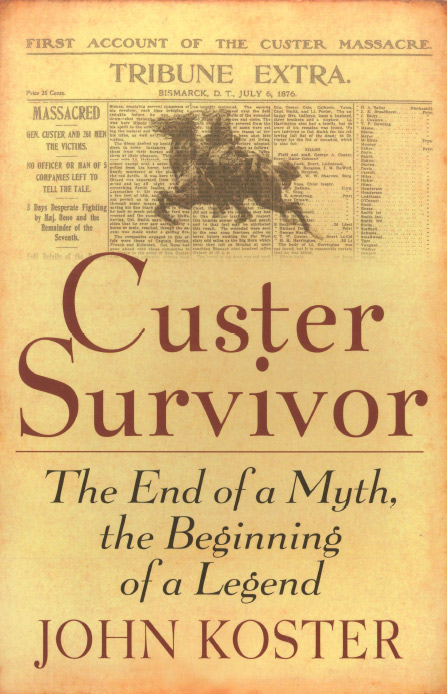Is There A Custer Survivor From The Battle Of Little Big Horn?
By Mike Yurk
The Finkel Files
 One of the most famous battles from our country’s long military history is the Battle of Little Big Horn, also known as Custer’s Last Stand.
One of the most famous battles from our country’s long military history is the Battle of Little Big Horn, also known as Custer’s Last Stand.
Everyone knows the story. On June 25, 1876, Lt. Col. George Custer led five companies of cavalry into the Little Big Horn to attack a large Indian camp of Lakota Sioux and Cheyenne. He was expecting a quick victory, but it went terribly wrong for him and his soldiers. The Indians counterattacked and completely wiped out Custer and the soldiers who followed him. The American cavalry, including Custer, were killed to the last man.
But were they all killed? That is an intriguing question that has remained for the last 136 years since the battle.
There were survivors. The Indians survived as did two other elements of Custer’s unit that got pinned down on the opposite end of the battlefield. However, of the five companies that attacked with Custer, history tells us that every man died.
There have been people who came forward some years after the battle claiming to have been with Custer at Little Big Horn. Their stories have all proven false, confirming that everyone with Custer died that day in June.
However, there might have been one man that did survive the Battle of Little Big Horn. His name was Frank Finkel and his story is told in a book, “Custer Survivor,” written by John Koster and published by Chronology Books/History Publishing Company LLC.
Frank Finkel was born on January 29, 1854, to Peter and Magdalene Finkle. The spelling of Finkel with several different variations is part of the mystery. Peter emigrated from Germany sometime in the early 1840s and spelled his last name F-i-n-c-k-e-l. He married and bought a farm in Ohio, and, in 1860, the official census taker recorded the family name as Finkle.
Frank grew up farming, and when his father died when Frank was 15, he left the farm. In 1872 he found himself in Chicago and decided to join the United States Army. Here some of the mystery gets a little deeper. Frank spoke perfect German, so he passed himself off as a few years older than he actually was and claimed to be a former Prussian soldier. In the years after the Civil War, many soldiers from Prussia immigrated to the United States and were prized recruits into our Army because of their previous military training and experience. This could also result in enlisting with a higher rank than an entry level private, which meant more money.
Frank Finkel joined the Army, changing his first name to August and using his father’s original spelling of their last name, Finckle. Four years later he found himself attacking the Indian camp at Little Big Horn with Custer.In what apparently were the early stages of the battle, Finkel was wounded in both the leg and shoulder. Then a bullet shattered the stock of his carbine, slamming it into his head. He was knocked semi-conscious, falling forward onto his horse. His horse, also wounded, began to run wildly through the Indian camp. Years later, Indian witnesses said that they saw what they thought to be a dead soldier on his horse running through the camp. Since he appeared to be dead, no one bothered to pursue him.
Sometime later Finkel woke to find himself still on his racing horse and some many miles away from the Little Big Horn. For the next two days Finkel and his horse wandered in what he thought was an eastern direction. Eventually his horse could go no further, as it was dying. Finkel shot the horse and continued walking for several more days. He was dazed, exhausted and wounded and now on foot when he wandered into a camp of two men. One of the men was dying of tuberculosis and the other one was caring for him. Finkel stayed with them, and the healthy man nursed both patients. Sometime after the one man died, Finkel became healthy enough to go on.
He wandered into a boom town called Fort Benton on the Missouri River. That was where he found out that Custer and every man in the five companies that fought with him died in the battle. He saw his own name on a list of the dead that was published in a newspaper. Since he was listed as dead anyway, he decided to keep moving west. Also, he was concerned that if he turned himself into the military, they might consider him a deserter in the face of the enemy. In those days military deserters could be executed.
Finkel finally reached Washington State and settled in the town of Clayton. He married a young woman named Delia Rainwater who was reported to be part Indian. They had five children, one that died in infancy. Finkel became a successful farmer, and, as a result, he and his wife became influential people in the small town of Dayton. Again, in several different official local papers, such as deeds to land and wills, the Finkel name was spelled both as F-i-n-k-e-l and as F-i-n-k-le.
Throughout the years Finkel kept his history at the Battle of Little Big Horn a secret, even from his wife, although apparently she had noted the scars from his wounds. Her husband said they were the result of being shot in an Indian fight.
His secret eventually came out on a Sunday afternoon over a game of horseshoes. A couple of men who were at the Finkel farm for Sunday dinner got into a discussion of the Battle of Little Big Horn when Finkel blurted out that they didn’t know what they were talking about. They asked him to explain, and Finkel took them inside to show them the scars from his wounds and finally told his story.
Although he gained some local notoriety, he didn’t try to generate any more publicity for his exploits. In 1921 Delia died, and sometime later Finkel married a woman named Hermie. His second wife seemed to take a lot more interest in Finkel’s involvement in the Battle of Little Big Horn. In 1930 Finkel died, and eventually Hermie remarried a man named Henry Billmeyer. They eventually ended up living in Oshkosh, Wisconsin.
From the 1930s until her death in 1951, Hermie promoted a campaign to have her late husband recognized as the only Custer survivor of the Battle of Little Big Horn and possibly to gain a veteran’s widow pension for herself.
Unfortunately, Hermie decided that the name her first husband enlisted under was Frank Hall. This inaccuracy muddled any attempt she made to press her case and has muddied the water ever since for historians.
In the book, Koster details physical evidence to support his claim that Frank Finkel was the only surviving member of Custor’s five companies that accompanied him that tragic day in 1876. According to Koster, the physical descriptions, as well as handwriting analysis, indicate that August Finckle, who rode into the Battle of Little Big Horn, and Frank Finkel from Dayton, Washington, claiming to be a Custer survivor, are the same person.
There will always be skeptics and “Custer Survivor” will long be debated. After reading the book, I found Koster’s premise to be probable from the evidence he presented. I talked to Scott Cross, who is the archivist at the Oshkosh Public library, and verified that the papers and records that Koster refers to as the “Finkel Files” are there; however, they are officially filed under the name of Finkel’s second wife, Hermie Billmeyer.
Of those who dispute the conclusions that Koster has made is Michael L. Nunnally. He apparently has studied Custer’s Last Stand and disagrees with Koster’s book. He has written a review on Amazon.com, and he and Koster have exchanged a number of responses that can be viewed on Amazon.com, along with Nunnally’s original review.
Scott Cross, the archivist at the Oshkosh Public Museum, also disagrees with Koster’s conclusions, citing discrepancies and inconsistencies in some of the evidence. He is also completing a book on the subject.
Read Koster’s book and the reviews and make up your own mind. Did one of Custer’s soldiers who rode into battle with him on June 25, 1876, actually survive Custer’s Last Stand?









